Carbs vs sugar – this area of nutrition seems to be a very common confusion, especially in terms of managing diabetes.
One of our readers recently said: “I’m trying to figure out the carbs and sugars but I don’t know how many of each to consume so I feel like I don’t know anything.”
Does this sound like you?
Well hang on because by the time you finish reading this, it should clear up all of your confusions about carbs vs sugars.
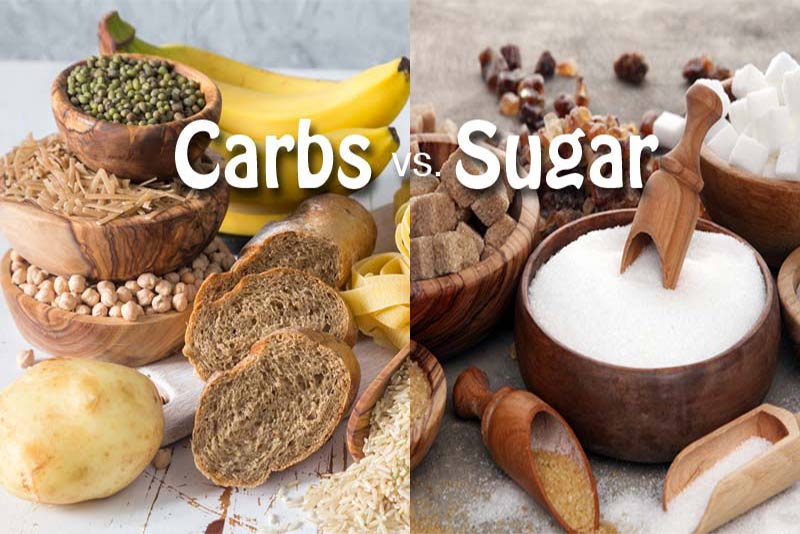
Carbs vs Sugar: The Basics
Having type 2 diabetes, you’ve no doubt become aware of the concept of carb counting. The reason for watching carbohydrates so closely is because carbs are the nutrient that influences your blood sugar and A1c levels more than other nutrients. Therefore, eating too many carbs makes it very difficult to get your numbers within a healthy range.
But here’s the thing: Carbohydrates and sugar are not two different things. Sugar is a carbohydrate so therefore, if you’re counting carbs, you don’t need to count sugar as a separate thing, because sugar is a carb.
Complex Carbs vs Simple Sugars
Someone else said: “Understanding sugar is easy, understanding carbs defies common sense.”
It’s true, we all know what sugar is – that white (or sometimes brown) sweet stuff that’s highly addictive!
But the category of carbohydrates can be one of the most difficult ones to get your head around, at least at first. Most of us can easily identify a source of protein or fat, but carbohydrates are a little more difficult.
The reason for this is because carbohydrates cover all the different types of plant foods, and there are a lot of them. They basically come under the categories of – grains/cereals, beans/legumes, fruits and vegetables.
Under these categories there are complex carbohydrates and simple carbohydrates. These can also be called complex sugars and simple sugars. Sugar is a carbohydrate – a simple carb/simple sugar.
On the other hand, whole grain pasta is a complex carbohydrate. But at the end of the day, complex carbs still break down to simple sugars, it just takes longer and the digestion process is different to the quick absorption that occurs with simple sugars.
While this can get complicated, it’s really not: sugars are carbs and carbs are sugars. At the end of the day, all digestible carbs end up in your bloodstream – plain and simple.
Carbohydrates vs Sugar: Nutrition Labels Debunked
What you want to look for on food labels is the TOTAL CARBOHYDRATES.
Look for the grams not the percentage. And remember that everything on the label (including the grams of carbohydrates) is reflective of the portion size listed on the label (which is often smaller than you think).
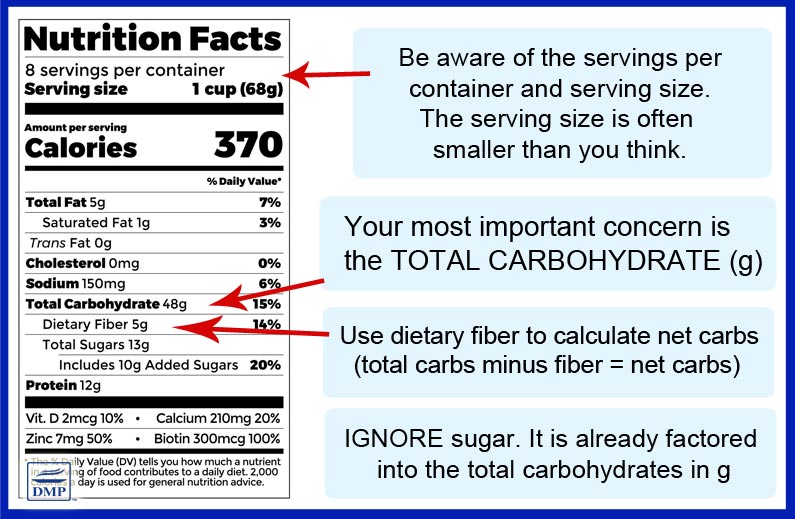
Fiber is not really digested, passing through the digestive system to help keep things moving and feed gut bacteria, therefore, the ‘available carbs’ left for absorption is referred to as ‘net carbs.’
You calculate net carbs by subtracting the amount of fiber: total carbs minus fiber = net carbs.
What About Sugar on Labels?
Sugar is important too! But carbs are most important.
Here’s why: if you take a look at a label, notice how the total carbohydrates is a big bold number, whereas sugar, dietary fiber, and sugar alcohol are indented underneath. That means these are subcategories of total carbohydrates.
What that means is that the sugar is already factored into the total carbohydrates (g).
In terms of sugar, all plant foods have some form of “natural” sugar within their makeup. Some food labels will distinguish between “added” sugar and “natural” sugar, but some won’t, so this can make it difficult to determine how much “added” sugar a food contains.
A good rule to determine the quality of a food is to read the ingredients list. Or better yet, purchase fresh foods that don’t require a nutrition label!
However, keep in mind that regardless of whether added sugar or natural sugar is stated on the label or not, both will have a similar impact on your blood sugar and A1c levels.
We’ve got a full tutorial on food labels coming soon, so keep an eye out for that as we’ll talk about all the other things (sugar alcohols, fiber, fat, protein etc).
Please pin, tweet or share; then keep on reading.
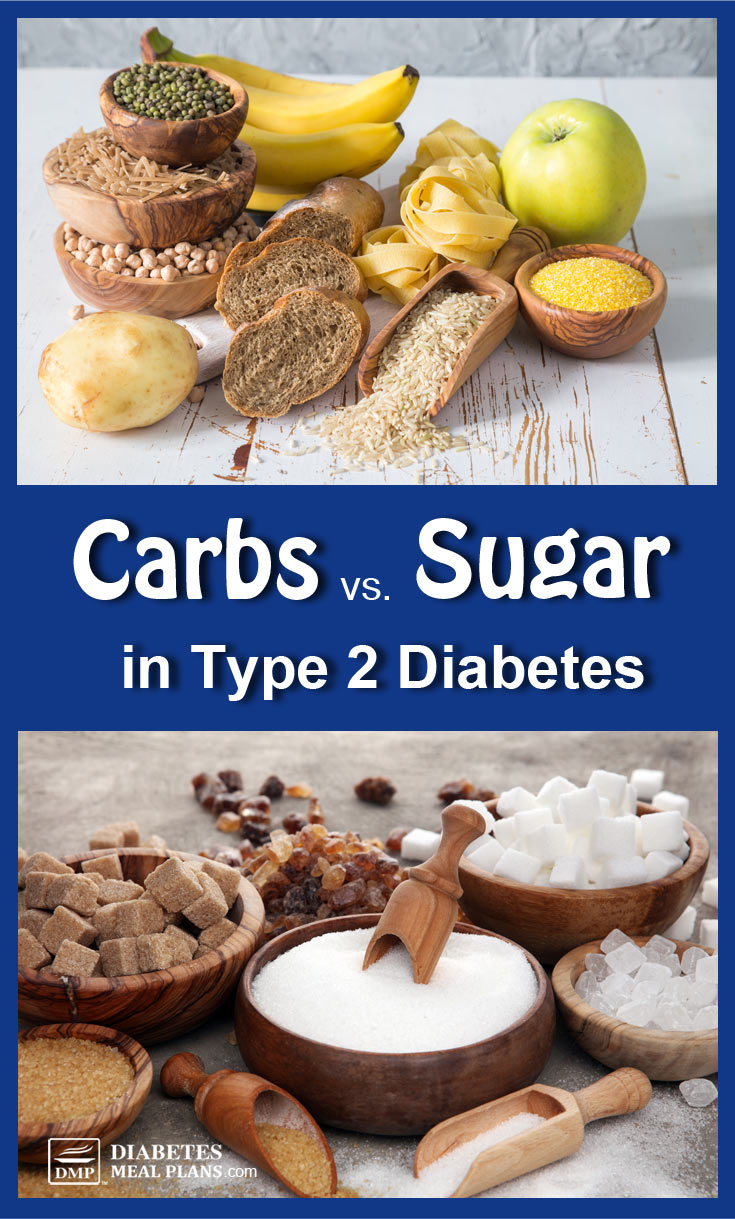
Carbs or Sugar: What is Worse?
Well, sugar in and of itself is not a friend of any person with or without diabetes.
We all know that “added” sugar is now included in thousands and thousands of grocery store items. And that’s a large part of our dietary (and health) issues – our bodies are just not designed to consume that much sugar.
The World Health Organization recommendations suggest to eat no more than 25 g or 6 teaspoons added sugar per day. In reality, many people eat much more than this, because it is in so many packaged foods.
Without a doubt, added, pure sugar is one of the worst offenders in our modern diet.
However, there are also lots of other simple sugars/ simple carbs in our diet that are equally as bad, and these are classified as ‘carbs.’ For instance, white pasta, white flour, white crackers, white bread, etc – all the refined and highly processed ingredients that are very high in carbs.
For a person with type 2 diabetes or prediabetes, monitoring carb intake is essential. It’s the difference between good blood sugar and A1c numbers that are within the normal healthy range (protecting you from diabetes complications), and high blood sugars in the 200’s or 300’s (leading to serious health issues).
The reason for this is that carbs (and that means sugar too) are the nutrient that influences blood sugar and A1c the most, more than any other nutrient.
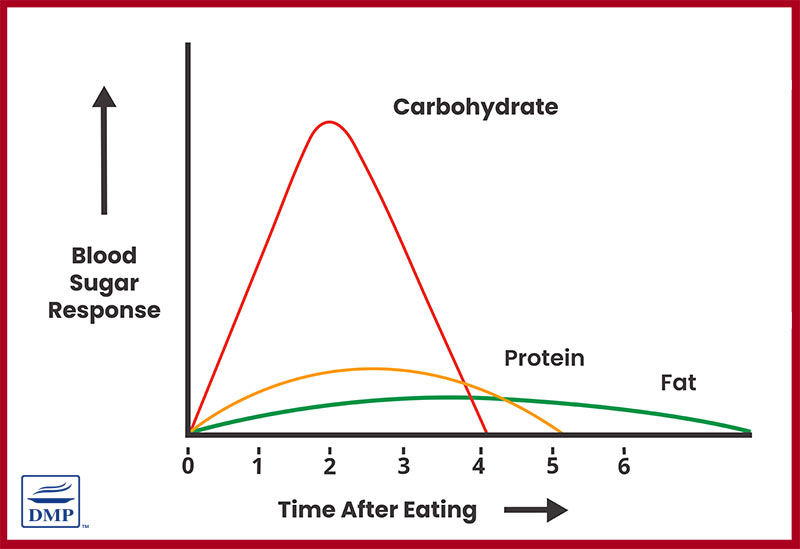
Sorry to harp on about this fact but it’s something you need to understand.
When carbohydrates in the diet are too high, many people with diabetes struggle to lower their numbers. But the thing is, oftentimes people are eating carbohydrate foods they “think” are “healthy.” For instance, oatmeal for breakfast, whole grain bread, whole grain pasta, brown rice, or brown crackers. Then, they wonder why their numbers are still high.
Here’s the reason: all of these foods a very high carb foods.
If there’s one takeaway you can use right now it’s this: Cut out rice, potatoes, pasta and noodles, cereals, crackers, and bread – and you will see a big difference in your numbers.
Although these foods are complex carbs and they are “healthier” than their white companions. They still don’t fit in a diabetic diet. Many people who continue to eat them, struggle to achieve good control of their blood sugar and A1c levels.
Carbs in Honey vs Sugar
The subject of sweeteners is another area of confusion. Essentially, all sugar, whether it’s a “natural” sugar or not, has the same amount of carbs.
Take a look at this chart:
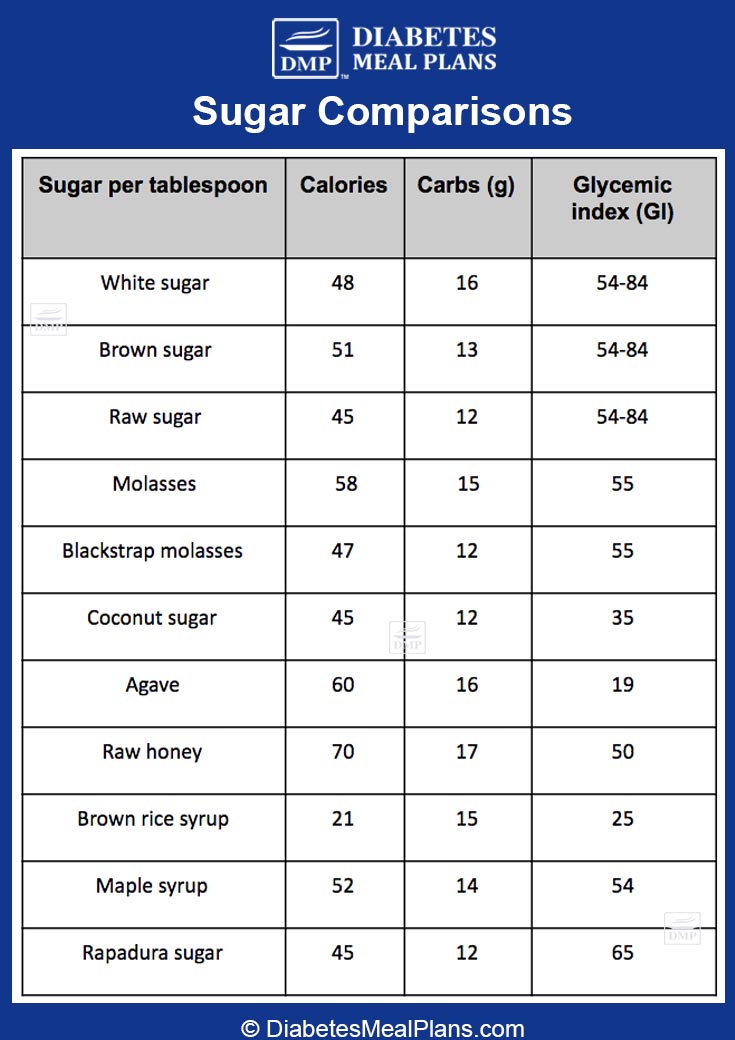
All of these sugars, “natural” sugar are all sugar nonetheless. So honey and sugar are really exactly the same thing, especially in terms of blood sugar management.
Taking the Pressure Off the Carb Ordeal
Not all carbohydrates are “bad.” In fact, carbohydrate foods are some of the healthiest foods you can eat, for example, veggies such as broccoli, tomato, zucchini, eggplant, leafy greens etc. These provide fiber, vitamins, minerals, polyphenols, flavonoids and various other beneficial compounds that all boost your health.
The way to relieving a lot of the pressure of calculating carbs is just to stick to this blood sugar friendly food list.
Our weekly meal plans are also designed off this food list and many members use the meal plans, without the need for counting carbs – and they are getting great results with blood sugar and A1c.
“I just wanted to share my great results having been on this plan for only one month. 3 months ago my A1C was 8.7 and my recent blood work showed it at 7.4. My endocrinologist was very impressed and thinks I will be at the target level by my next testing in 3 months. I am excited to continue on this plan and maybe I can stop one of my injections. Thank you for your dedication to diabetes research and food plans.” ~Gloria G (VIP Member)
It may be more helpful to you to visualize food choices by referring to this diabetes food pyramid.
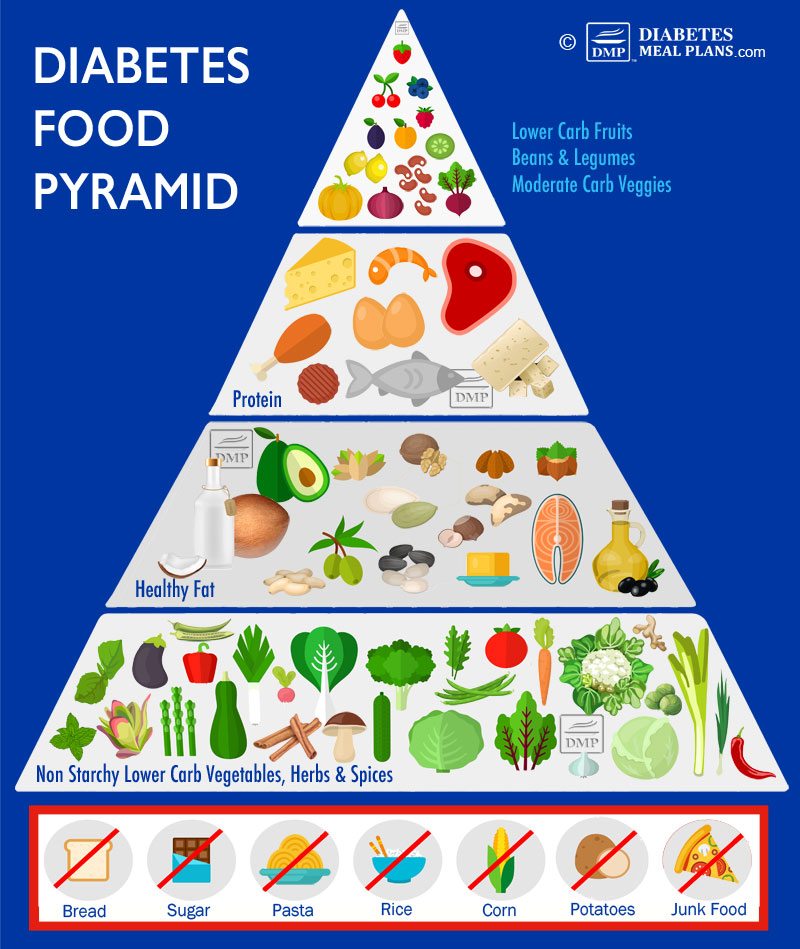
The thing is, if you cut out the high carb foods mentioned above, and stick to the blood sugar friendly food list, the carb pressure is relieved and you can enjoy an abundance of delicious foods, without getting too caught up in the carb counting ordeal or the feelings of deprivation.
Conclusion
Carbs are not bad by any means and your goal should not be to avoid them at all costs – only the carbs that are problematic – the type that are high in carbs.
To make this a bit easier, this includes all grains/cereals. If you cut out those, you’re going to see big changes in your numbers. Beans and legumes need to be portion controlled because they are high in carbs. Most fruits need to be avoided.
In terms of veggies, steer clear of corn and potatoes, but other than those, most veggies are a great carb to eat.
While this may sound restrictive, it’s actually not. All you need are options and alternatives and there are plenty of those. That’s why we have weekly meal plans – to help you enjoy life more while regulating blood sugar and A1c.
You can leave the planning to us and enjoy deliciously tasty blood sugar friendly meals each week.
Please pin, tweet or share this info to help others – thanks!


Fritz
One point of confusion (for me) not addressed in this excellent article is compare sugar and carbohydrates listed in different proportions. For example, which one is “better” in the context of “its all sugar in the end” ideology?
1) Something that has – 15g total carbs / 6g sugar (4g added sugar) / 4g dietary fiber
2) Something that has – 10g total carbs / 10g sugar (2g added sugar) / 4g dietary fiber
3) Something that has – 10g total carbs / 10g sugar (9g added sugar) / 4g dietary fiber
If I go just by the net carbs, #2 would be best even though it lists a higher sugar content (or added sugars for that matter).
Thank you for the informative article.
Dr Jedha
This is a great question Fritz and why we need to check labels as it can vary and will take a bit of judgement dependent on the quality of the product. Total carbs is the total number including all items, sugar is the natural sugar in the item, ‘added’ sugar is other sugars added to the item, and then fiber. Of the options presented, option 2 and 3 are the lowest in net carbs, both 6g, but option 2 is probably best. It has less ‘added’ sugar than the other options. Option 1 could still be fine as it contains low amounts of sugar overall so could indicate a better product, although still having a higher net carb count at 11g. Definitely a good topic for us to dig into further so will add it to our list!
Theresa
What do you do when your carbs won’t digest and go right to sugar, making it even MORE difficult to lose weight. Plus, I have Hashimoto Thyroiditis, which complicates things even more. And I am on medication for that. T.
Dr Jedha
Theresa, you may need to reduce your intake of carbs, that is a good place to start. Grab a copy of our free recommended food list HERE, it will help guide you in the right direction.
wells carey
if carbs and sugar are the same why are they listed separately on package ingredients
Dr Jedha
Sugar is listed as a subcategory of carbohydrates, not a separate category, so the total carbs includes sugar.
Sandi
Finally the truth! How many doctors, nurses, and nutritionists have I argued with or have just flat out ignored because my experience told me they were wrong in their diabetic nutrition advice? I told my doctor once that if I followed their advice they’d end up killing me. So many fallacies surrounding nutrition is still, to this day, being taught in colleges and repeated by doctors to their patients. I learned these truths by accident. I know that diet (the right diet low in carbs) can completely control my diabetes without medication (previously I was on mealtime sliding scale and a 24 hour long acting insulin plus oral medication). It’s not a cure, but it’s controllable. Thank you for this article. It’s what I’ve been telling others for years now.
Yvonne
Hi..i have boarder line diebetes…have been eating a potatoe at night…down to a small one now…
Like all kinds of fruit but I see have to cut back..
I thank you for sending me info….
I was told to follow the canada food guide …portions are small!
Thank you
Yvonne [email protected]
Emily - Dietitian (MS, RD)
A small baked potato contains around 25 grams of carbohydrates; to help put this in perspective, we encourage people to consume around 80 grams of carbohydrates per day. You may find that ditching the potato and choosing more non-starchy vegetables improves your blood sugar and prevents you from developing type 2 diabetes. Remember, carbs are the nutrient that most effect blood sugar levels.
Check out this article for the best fruit to pick when you decide to consume.
Rosemary
Do you count the total carb grams in a food or the net carbs for best blood glucose level control?
Emily - Dietitian (MS, RD)
You will definitely achieve the best control by counting total carb grams but using both measures can be useful because fiber is not really digestible. Here is more info between using total vs net carbs that you may find interesting. And one on carbs per day.